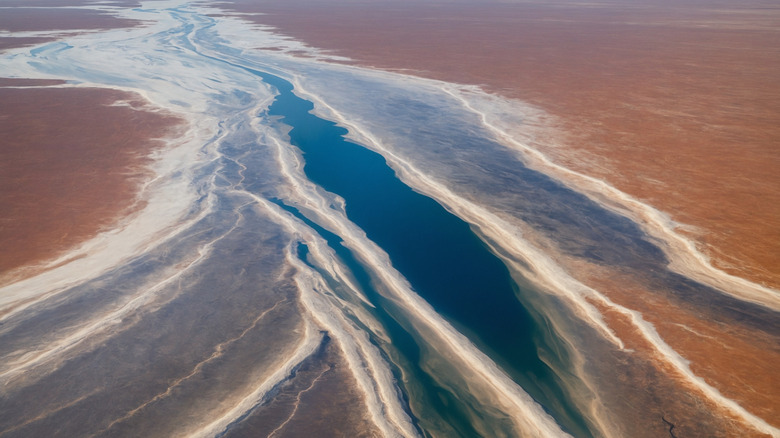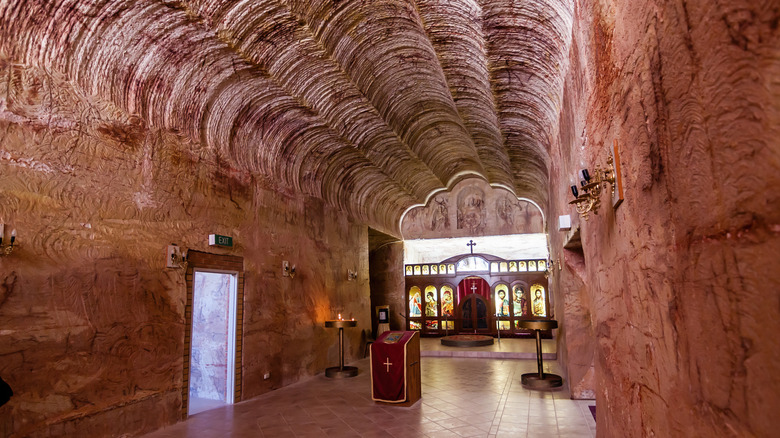Australia's Largest Lake Is A Scenic Desolate Destination Unlike Anywhere Else In The World
Australia is a country of contrasts -– dazzling harborfront cities, vast stretches of uninhabited land, vibrant underwater worlds, rainforests, and deserts spanning thousands of miles. Being a massive island, it's ringed by more than 21,000 miles of coastline, offering endless choices for outstanding island and coastal getaways. Many people know about Uluru and the Great Barrier Reef, but the country's pink lakes are natural attractions that aren't as well known. There are a number of them spread across the continent including Lake Hillier in the Australia's aquatic adventureland of Esperance. Another lake that can turn pink is Australia's largest saltwater lake, Kati Thanda–Lake Eyre.
Usually referred to as just Lake Eyre, it measures 89 miles long and 48 miles wide and lies within Kati Thanda–Lake Eyre National Park in the remote outback of Northern South Australia. The largest city nearby, Adelaide, it isn't actually close at all since it's more than 400 miles south. Desolate and scenic, its landscape changes depending on the water level. Lake Eyre is unique because of its size and because it's Australia's lowest geographical point, at 49 feet below sea level. This means that this lake can be dry, with light reflecting on its glimmering white surface, or it can become swirls of colorful water that create a pop-up ecosystem with enormous flocks of birds and other fauna and flora. The lake only fills completely about three times every 160 years, though partial floods happen every three to 10 years.
The magic of Lake Eyre
Lake Eyre is an ephemeral salt lake — dry most of the time, but occasionally alive with rainwater. In its dry phase, a salt crust shines in the unforgiving sun as far as the eye can see like a giant mirror. When heavy monsoon rains flood rivers, a shallow lake appears with fish and their avian predators, and the water brings wildflowers and other plants to life for several months. As the lake becomes saltier during evaporation, a microalgae called Dunaliella salina releases beta carotene, and when this combines with halobacteria, a rainbow of pinks, reds, oranges, and purples can appear.
Lake Eyre is reachable via land, but a terrestrial approach is much more labor intensive, time consuming, and dangerous. If you are driving, travel in a four-wheel-drive vehicle, check road conditions, carry enough food, water, and fuel, and purchase either a Desert Parks Pass or day permit to enter Kati Thanda–Lake Eyre National Park. Note that there is no cell phone coverage in the park. The best way to experience the enormity of the lake and see its colors or mirror-like surface is in an airplane. Numerous outfitters organize sightseeing trips both from surrounding areas like William Creek, Marree, Roxby Downs, Coober Pedy, and Adelaide, and also from Sydney and Melbourne, across the continent –- demonstrating people's interest in this unique natural phenomenon. The best time to go is during Australia's winter and spring, April to October. Avoid the extreme summer heat December–March.
What is around Lake Eyre
Australia is not short on stunning landscapes like the Kimberley's town of Broome, a coastal gem where red cliffs meet turquoise seas. Broome is also in the Western part of the country but not as close (a relative term in Australia) as William Creek. The closest town to Lake Eyre (37 miles away), William Creek is known for the William Creek Hotel (with rooms starting at around $100 AUD, depending on when you book) and a pub covered in travelers' memorabilia. Scenic flights leave from William Creek to Lake Eyre and also to the Anna Creek Painted Hills. Only accessible by air, this is a colorful, remote range of hills striped in bands of orange and red. En route, you'll fly over the world's largest cattle station, Anna Creek Station, and it's possible to land and hike among these colorful natural formations. Flinders Ranges and Ikara–Flinders Ranges National Park are destinations for adventurers ready to climb rugged mountains and hike through gorges on the lookout for Aboriginal rock art and an awe-inspiring night sky.
As Australia is full of surprises like pink lakes, why shouldn't there be an underground town? Coober Pedy produces most of the world's opals and it's not only opal miners who head underground. Because of the town's inhospitably hot climate, residents built subterranean homes, churches, and hotels. Not surprisingly, the name Coober Pedy comes from an Aboriginal phrase meaning "white man in a hole." Rooms at the well-named Underground Motel start at $150 AUD.


